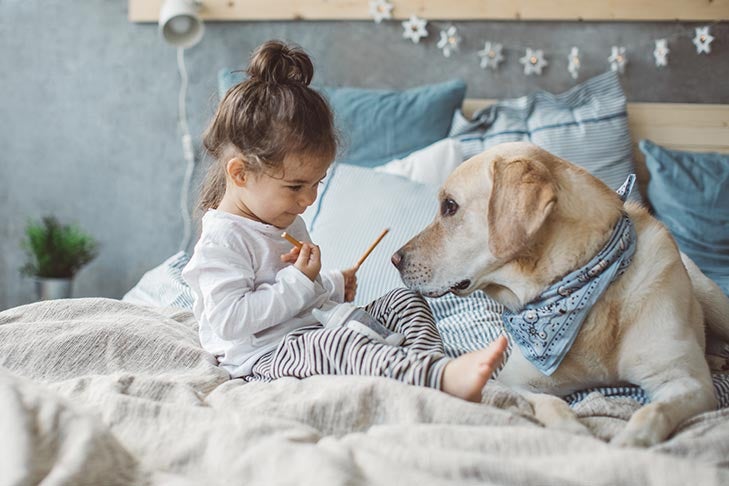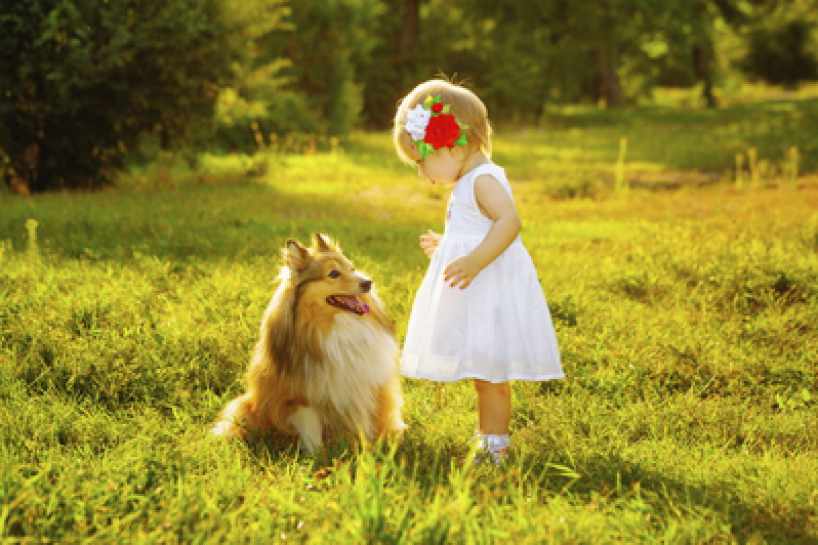How Did Your Dog Act Towards New Baby
- Provide your dog the space – both mental and physical – to adjust to a new baby
- Reward dogs for behaving positively around your baby
- Many dogs, like people, just need an adjustment period
I've had my share of litters – and not just canine ones. You see, I'm the mother of triplets.
When Stephen, Allie, and Krista came into my life – in that order, a couple of minutes apart – I had two middle-aged Rhodesian Ridgebacks. Blitz and Diva had certainly met children before, and didn't mind them, but the arrival of the babies rocked their world. Pre-kids, my husband Fred and I went to work, and they lazed around our suburban Victorian, maybe getting exorcised over the occasional oil delivery or Fed Ex dropoff. But post-kids, there was a literal village tromping through the house – grandmothers, babysitters, a visiting aunt from Italy – and these, these … creatures.
Diva, an old hand at motherhood herself, decided avoidance was the best option: Anytime I sat down next to her with a baby in my arms, and a tightly balled fist or bootied foot grazed her, she got up without so much as a sidelong glance and, well, left. It was as if she had concluded that I didn't appreciate her messing with my litter anymore than she would.
Blitz, on the other hand, was a basketcase. Like many intact males, he had what one behaviorist I talked to eloquently called Old Bachelor Uncle Syndrome. He reacted to my newborn children the same way he did to newly whelped puppies presented under his nose for inspection: "Uh, what are these things? Ew, they smell weird. I thought I wanted to know, but – actually – no … " Backing away … backing away …
When my triplets started to toddle, he looked at them whale-eyed, just as he did with newly weaned puppies barreling around the room, running in between his legs, millipedes with fur: "What are these things? They still smell weird. Is one of them going to grab my testicles?" (A concern that proved prophetic.) Growling … growling …
It was a little unnerving having a 90-pound intact male Ridgeback vibrating like a tuning fork around my little swathed bundles of pinkness. But with my favorite remedy – tincture of time – and some hard-earned experience, we eventually overcame this reluctance. That first year of mixing dogs and babies was stressful, but it taught me more than any "What to Expect …" book could.
In fact, nobody really tells you what to expect when you bring a new baby home to an older dog. The advice books tell you what to do to prepare your dog for the arrival, but there's not much information about how to prepare yourself for what happens when things get a little bumpy.
Here is some hard-earned advice about both sides of the fence – acclimating dogs to little kids, and teaching little kids to share a home with four-legged siblings. And while it goes without saying, I'll, of course, say it: If at any time you are concerned about your dog's behavior, consult a qualified trainer or behaviorist.
The advice books are only a starting point
Yes, do the whole blanket-from-the-hospital shtick. Walk around the house with a doll and talk mindlessly to it. But it's no guarantee that your dog is going to seamlessly tradition from life before baby to the new nuclear-family reality.
Let's face it: Dogs are smart. They know the doll isn't a baby. But what they do know is that everything in their world is changing: As your pregnancy progresses, everything about you starts to morph, from your gait to your hormones to your routine. New furniture shows up. Rooms get rearranged. Your anxiety level peaks.
Any major life change requires an adjustment period, and dogs are no different. Just assume that this will be the case, and provide your dog the space – both mental and physical – to figure things out. When things get hectic, or out of control, give your dog crate time with a good chewie. Don't expect the Normal Rockwell painting out of the gate; for the first few months, it may be more paint by numbers.

Listen to the dog people
Babies and kids make people emotional – no way of getting around that. Fledgling grandmothers who in other aspects of their lives are unflappable turn into frantic Oracles of Delphi when your pooch so much as looks sideways at the new arrival.
Amid all the confusion and exhaustion of a new baby, it's easy to let other people get into your head. If it's an experienced dog person, that's one thing. But if it's someone whose sum total exposure to canines is a collection of German bisque Dachshunds, then keep that in perspective. People who understand dogs understand canine body language and instincts; people who don't are liable to misinterpret even friendly gestures – "He's LICKING HER! Oh, my God, HE'S LICKING HER!" – and can offer some rather insane advice.
Last week, on a visit to the periodontist, the chairside chatter turned to the assistant's newborn granddaughter, who was coming home from the hospital later that week. Concerned that the family dog was not going to accept the baby readily, the plan was to tranquilize him. I almost swallowed my cotton batting, and when I could come up for air I pointed out that this was a supremely bad idea; in fact, being woozy and out of control of his own body likely would put the dog more on edge, not less.
Center yourself
Dogs read your body language, your pheromones – and, the animal communicators would say, your thoughts. If you are anxious and worried about your dog's reaction to the baby, you are in a sense encouraging him to be. Find that sweet spot between vigilant and freaked out. Practice feeling it. Practice breathing normally and not holding your breath when the two are in the room together – that's the first sign to your dog that there is something to be worried about.
Don't run film loops in your head about the worst-case scenarios. Do try to envision a calm, serene encounter. This sounds simple, and in theory, it is, but in practice, it can be the most daunting hurdle you face, especially if you have a dog who's having difficulty with the new-baby transition.
Take baby steps
The most important thing to remember with anything involving dogs, or kids – or dogs and kids together – is that you can't expect a finished product right out of the gate. Plan out your encounters between dog and child – no matter what the age – and start simple: Create tiny successes and build from there.
In my Blitz's case, he exhibited a whole spectrum of emotions, starting first with excitement, leaping and snuffing. When he smelled the babies through the bars of the crib, he breathed their scent in so deeply he sounded like an Electrolux. Once the novelty wore off, and the babies became a fixed part of our routine, then bewilderment set in. He was fine as long as they didn't touch him. Once they did, the panicked looks and grumbling started.
We dealt with his behavior in a number of ways. To help center his emotions gently and without drugs, I added some appropriate flower essences to his water, like Walnut for dramatic life changes, Mimulus for fear and Rescue Remedy to kick it up a notch. (In my experience, when I have found the individual essences that work, adding Rescue Remedy often amplifies their results.) Whenever Blitz was around the babies and reacted without fear or concern, he'd get a click and a treat. To encourage him to make contact with them, I'd balance a piece of string cheese on, say, the baby's blanket-swaddled feet. (He was the gentlest dog when taking food – don't try this with a chomper.)

Corrections don't work when fear or anxiety is at the root of the problem; they only make things worse. But if I did hear a grumble when I sat beside Blitz on the couch with a baby and bottle, he was calmly but firmly ejected from his spot.
Fast forward five or so years later. Blitz was sleeping in the front parlor; my baby sitter was playing a boisterous game of tag with the kids, chasing them around the kitchen island. When their delighted screams reached his ears, he bounced off the couch, trotted over to the babysitter, and took her forearm gently between his powerful jaws. She stopped, the kids' screaming died down, and he released her, without so much as a tooth mark. Rather than being taken aback, she was pleased: He was telling her, eloquently but wordlessly, that he was worried about his children, and she needed to stop their screaming. Now.
When those babies first came home, I would have never thought that scenario possible. But many dogs, like people, just need an adjustment period.
Crate expectations
The books all say it, and its importance cannot be understated: Your dog's crate needs to be his sanctuary, and it is off-limits to kids. I can tell you from experience that preschoolers think a crate is the coolest kind of playhouse; it's small, it's snug, it's forbidden, and therefore irresistible.
I reserve the sternest kind of rebuke for any kind of messing around with the dogs' crates – not only going in them, but opening them without permission. My children grew up understanding that letting a dog out of his crate at the wrong time could have serious consequences. Being a multi-dog household with frequent visitors who don't always get along with the resident dogs – or who are in various states of reproductive readiness – there are cases where having the wrong two dogs out together could potentially result in disaster. I don't sugar-coat it – if you do this, this and this could happen, and that would be A Very Bad Thing.
Kids aren't the only ones who can mess up in this regard: If you have babysitters, nannies, visiting relatives who take on dog care as part of their household helping, you can't rely on them to be as vigilant as you would be. In those cases, a snap-lock on the crate with a note – "Do not let out!" – reminds them in your absence.
Continue to read part 2 — Teaching Young Children to Respect Dogs
How Did Your Dog Act Towards New Baby
Source: https://www.akc.org/expert-advice/training/introducing-dog-to-baby/
0 Response to "How Did Your Dog Act Towards New Baby"
Post a Comment